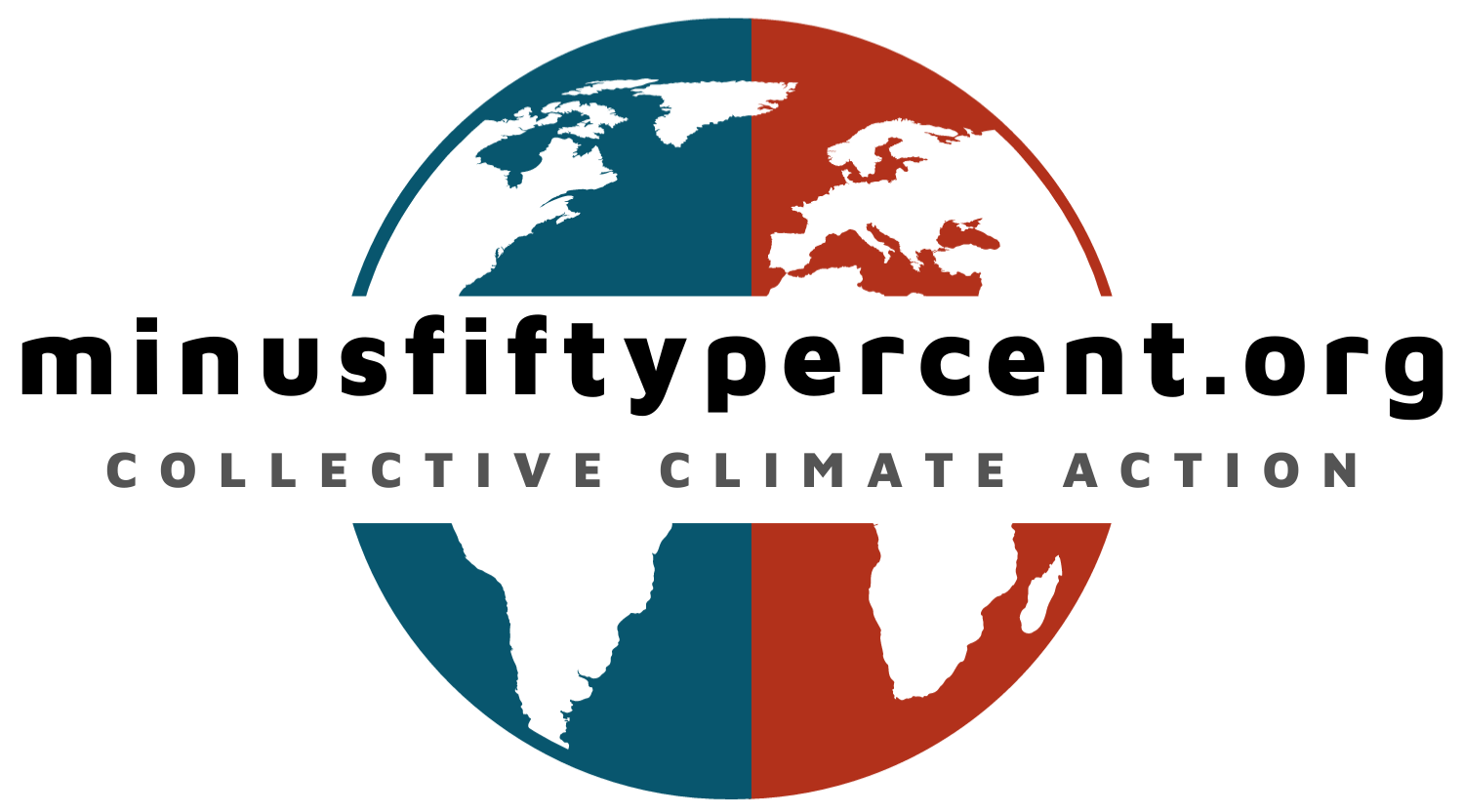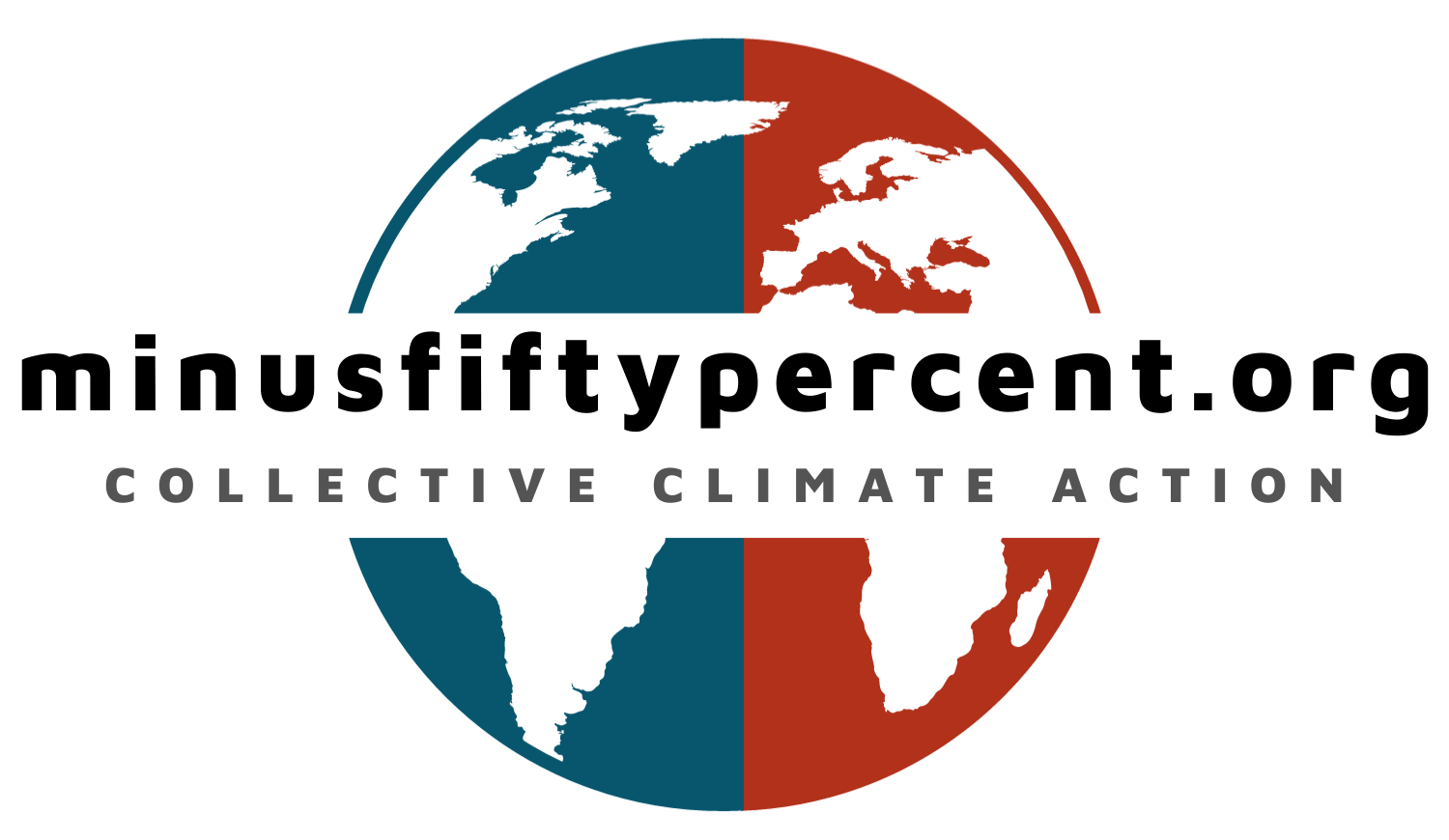Download pdf
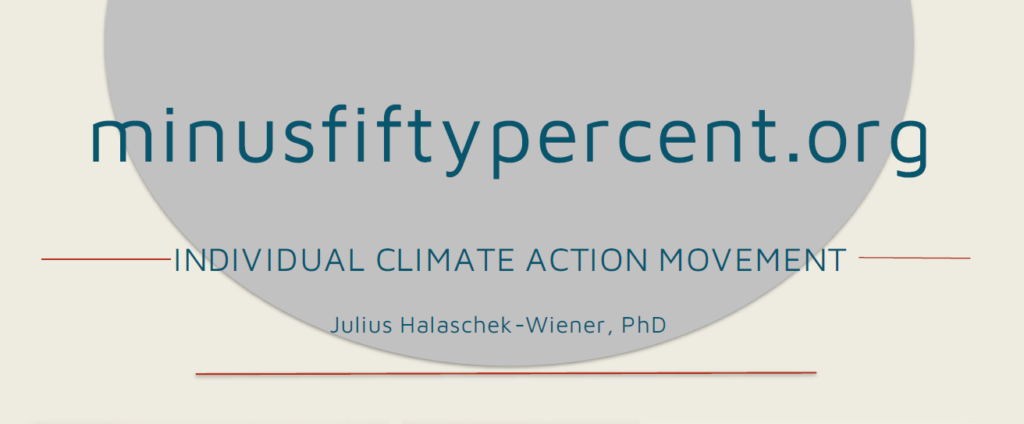
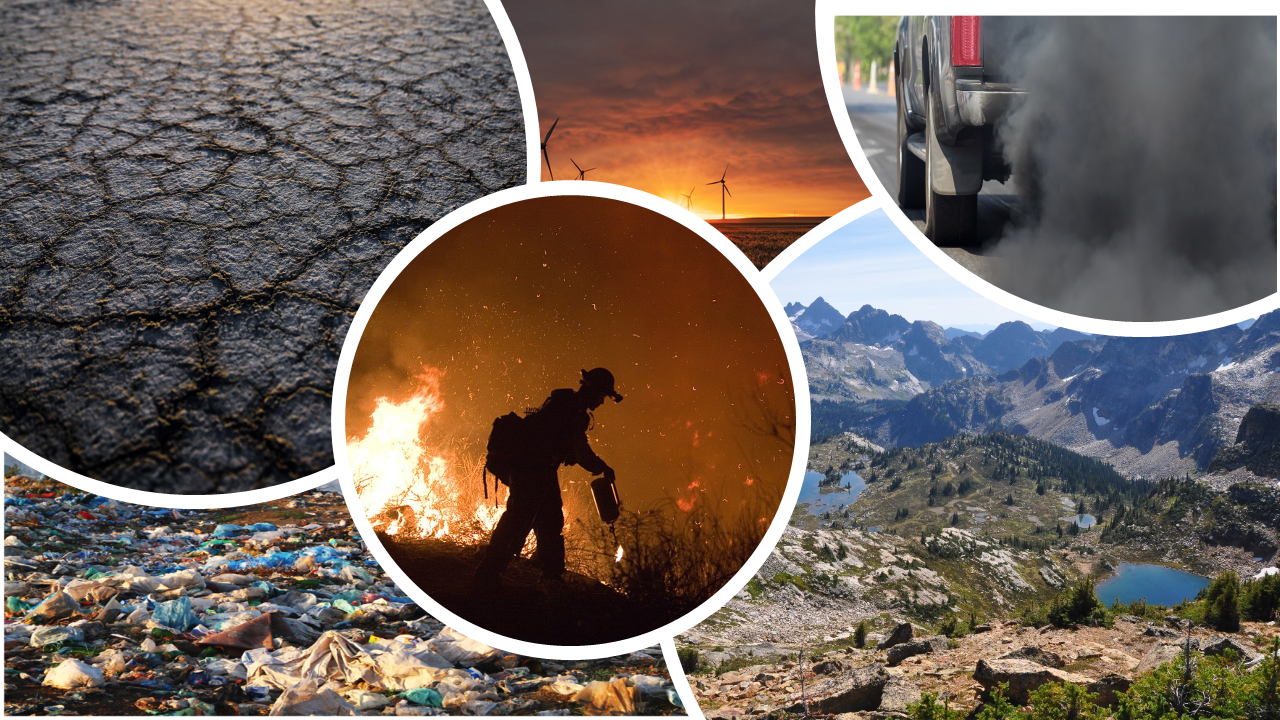

EXECUTIVE SUMMARY
 In early 2021 there is unambiguous scientific consensus that the Earth’s climate is warming, caused by greenhouse gas (GHG) emissions from burning fossil fuels. The 2016 Paris Climate Agreement stated that the world’s long-term temperature goal is to keep the increase in global average temperature to well below 2°C above pre-industrial levels; and to pursue efforts to limit the increase to 1.5°C, recognizing that this would substantially reduce the risks and impacts of climate change. To achieve this goal, human emissions will need to be reduced significantly. Without drastic action, our planet is headed toward warming of 3.2°C in less than 100 years. It will result in increased frequency and intensity of environmental disasters, such as floods, wildfires, droughts, rising sea levels, food and drinking water shortages, mass migration, social conflicts and wars. Everybody and every living being will be affected.
In early 2021 there is unambiguous scientific consensus that the Earth’s climate is warming, caused by greenhouse gas (GHG) emissions from burning fossil fuels. The 2016 Paris Climate Agreement stated that the world’s long-term temperature goal is to keep the increase in global average temperature to well below 2°C above pre-industrial levels; and to pursue efforts to limit the increase to 1.5°C, recognizing that this would substantially reduce the risks and impacts of climate change. To achieve this goal, human emissions will need to be reduced significantly. Without drastic action, our planet is headed toward warming of 3.2°C in less than 100 years. It will result in increased frequency and intensity of environmental disasters, such as floods, wildfires, droughts, rising sea levels, food and drinking water shortages, mass migration, social conflicts and wars. Everybody and every living being will be affected.
To prevent warming beyond 1.5°C, the global community needs to reduce GHG emissions by 7.6% every year from 2019 to 2030. In 2019, emissions still rose by 2.6% and only dropped briefly by 7% in 2020, due to the global emergency COVID-19 pandemic lockdown. This temporary dip will not be sustained and hence will make no significant difference to long-term climate change.
The regions that are already affected can be seen on the daily news: historical wildfire seasons in California, Australia, Western Canada and the Amazon Rainforest; hurricanes and tropical storms (US coast and Caribbean), rising sea levels (Kiribati), flooding or melting glaciers in Europe and elsewhere.
Who is to blame for putting all these greenhouse gases into our atmosphere? About two-thirds of global emissions are linked to private households. Developed nations, in particular the wealthiest ones, bear the greatest responsibility. The combined emissions of the richest one percent of the global population account for more than the poorest 50 per cent. The richest 10 percent accounted for over half of the emissions added to the atmosphere between 1990 and 2015. It is our flying, driving, meat and energy consumption, and consumerism that drives up GHG emissions. The wealthier we are the more GHG emissions we produce.
The Intergovernmental Panel on Climate Change and numerous climate action groups demand immediate action to curb our fossil fuel consumption and GHG output. Some governments are starting to act, albeit slowly and hesitantly. Industries that contribute in major ways to climate change (oil, gas, coal, aviation, automobile, online shopping) show only limited interest in changing their ways. Government policies and improved industry standards are only one part of the solution, the other one is changing our individual behaviors. We individually need to stop burning fossil fuels, directly (driving, flying) or indirectly (coal-based electricity, shipping of online purchases). We need to reduce our meat consumption, rethink our consumerism habits and reconnect with the natural world.
We need to show governments, corporations, the world what we want – a stable climate, a better future, and restored nature. It is easy to blame others for not doing enough. It is hard to look at our own actions and conclude that they are equally disastrous. We need to lead by example.
Be introduced to minusfiftypercent, an Individual Climate Action Movement (minusfiftypercent.org): Reduce all your fossil-fuel powered, wasteful, unsustainable, polluting and socially damaging activities by fifty percent, starting today.
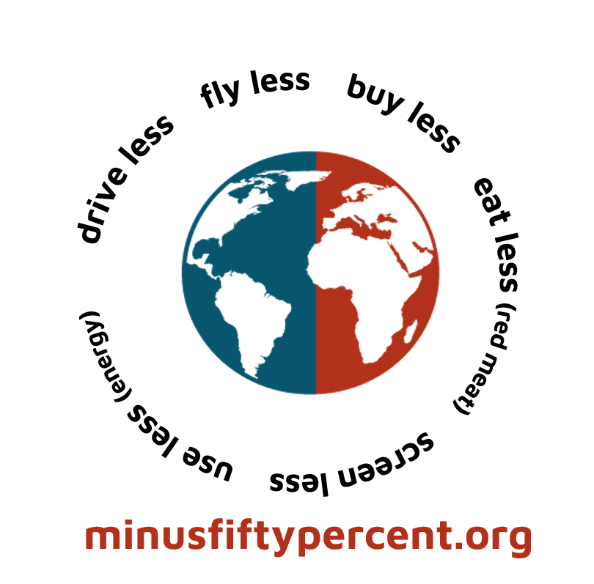 Calculating and understanding our carbon emission impact is very complex; what does it mean that the average Canadian emits 15 tons of CO2 equivalents per year and that our per capita allowance by 2030 is only 2.1 tons. How can I act on that without falling into jadedness, resignation and inaction?
Calculating and understanding our carbon emission impact is very complex; what does it mean that the average Canadian emits 15 tons of CO2 equivalents per year and that our per capita allowance by 2030 is only 2.1 tons. How can I act on that without falling into jadedness, resignation and inaction?
minusfiftypercent provides a simple formula; don’t worry about your current greenhouse gas output – it is too high, just start reducing it by 50 percent. “Never again” and stopping completely is too hard and will prove unrealistic and unsuccessful but reducing by half is doable.
minusfiftypercent provides a guide and a goal. The guiding categories of change are not entirely new and the goal is to reduce your impact by half. The time has passed for small incremental changes. What we need now is bold action in all of these five areas:
- Travel – primarily driving and flying but includes all fossil-fueled transport (boats, ATVs, etc)
- Energy Consumption – all fossil fueled heating and cooling, all electricity use
- Food – red meat consumption, high environmental impact & junk food, food waste
- Consumerism – All new goods (clothes, electronics), single use (plastic), online purchases
- Social Transformation – Nature deprivation, stress, screen time, addictive behaviors, money/debt, education
The question we have to individually answer is whether our own current pain, the pain observed in others and the predicted pain inflicted by a 2+ degree Celsius warmer planet is significant enough to make substantial changes to our own lives right now. Our reward is knowing that we are doing the right thing – for the future; for our children and grandchildren and the living world at large. These changes to our behaviors need to be permanent, forever; no going back.
There are some hard lessons learned from the 2020/21 COVID-19 pandemic. Governments around the world took action and put rules and legislations in place to mitigate the spread of the virus; borders closed, flights grounded, mobility and social interaction restricted, businesses closed, masks mandatory. It will happen again when the effects of our climate crisis come to a boiling point. Emissions will need to be curbed, at all costs, similar to curbing COVID-19 infections.
During the COVID lockdown, the food, water and energy supply chains, together with all infrastructure were kept intact. Most goods were available. Education and health care systems continued to operate. If you had a home, you did not necessarily lose it. Most people kept their jobs or got some form of government support. Everybody stayed put and went inward, nobody moved. It was clear that the situation will get better.
The climate crisis will almost be the exact opposite: everything will be disrupted – food, water, infrastructure, goods and energy production, loss of homes and jobs and increased conflicts, migration and wars. No sophisticated quick-fix, next-generation vaccines will be available. Climate conflicts will be severe, as they will be about survival, affecting everybody. We will need to dig deep to find and sustain our hope in the midst of a decades-long climate crisis.
To lower our own greenhouse gas emissions and unsustainable behaviors we need an increased awareness of our own climate-damaging actions. We need a renewed connection with nature, rebuild our communities and find our heart for each other and the natural world.
minusfiftypercent – THE MOVEMENT
IT IS PERSONAL
I watch my sons. I look at climate predictions. I watch people’s behaviors and governments’ non actions. I personally watch floods every spring and smoke-filled skies from widespread wildfires every summer. I look out into the world, I look at climate protests and governments’ slow reactions, I look at the painful consequences of a warming climate.
I am left saddened and deeply worried, as I do not see the initiation of the immediate changes that are necessary.
Do you think climate change is real or nonsense? Do you witness any climate-related changes in your neighborhood? No increase in wildfires, floods or storms – all is good? Do you think the world is on a sustainable path? Is driving SUVs, flying around the globe for pleasure, thoroughly enjoying our coffees in throw-out cups, and consuming and wasting as we please the way to a bright future?
Well, I personally don’t think so and many scientists warn us insistently to change our path. Keeping our eyes shut to the current and future consequences of climate change, will not work any longer.
The minusfiftypercent movement summarized in this article asks everyone, every single person, to reduce their fossil-fuel powered, wasteful, unsustainable, polluting and socially damaging activities by 50%. The pain and suffering from a planet heating beyond 2°C will be unimaginable. We all need to change our behaviors, starting now, starting today.
THE PROBLEM
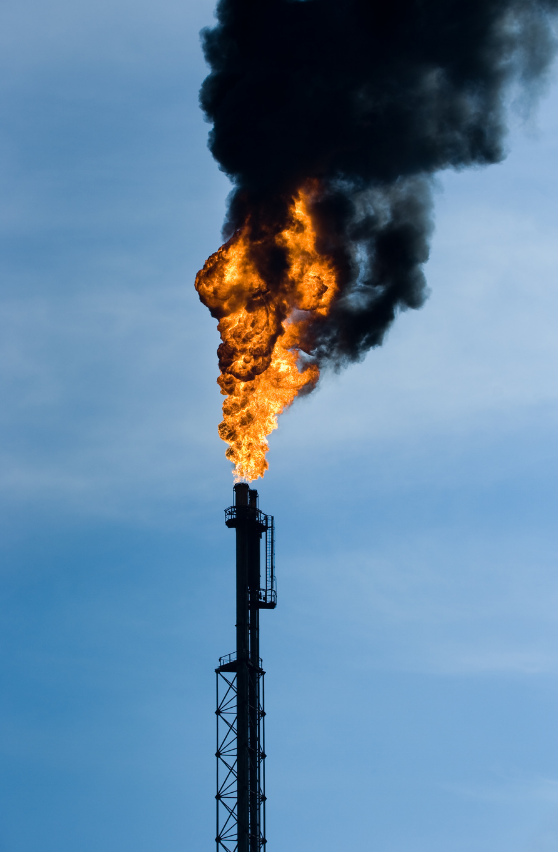 Greenhouse gases, such as carbon dioxide and methane trap heat from the sun and make life on earth possible. Increased concentration of greenhouse gases in the atmosphere causes the earth to get warmer and the climate to change. Since the industrial revolution, greenhouse gas concentrations are rising and the scientific consensus is that human activities are to blame.[1]
Greenhouse gases, such as carbon dioxide and methane trap heat from the sun and make life on earth possible. Increased concentration of greenhouse gases in the atmosphere causes the earth to get warmer and the climate to change. Since the industrial revolution, greenhouse gas concentrations are rising and the scientific consensus is that human activities are to blame.[1]
The scientific evidence speaks unmistakably; the world’s climate is changing and these climate-warming trends over the past century are directly linked to human activities.[2]
In 2016 more than 196 states signed the Paris Climate Agreement that outlines the long-term temperature goal to keep the increase in global average temperature to well below 2 °C (3.6 °F) above pre-industrial levels; and to pursue efforts to limit the increase to 1.5 °C (2.7 °F), recognizing that this would substantially reduce the risks and impacts of climate change. This goal can only be achieved by reducing human greenhouse gas emissions significantly and as soon as possible.
On our current emission path, a 1.5°C temperature increase will already be reached in the next few decades.
In fact, without drastic action, our planet is headed toward warming of 3.2°C in less than 100 years, according to a report released by the United Nations Environment Programme in November 2019.[3] Some may think that the difference between 2°C and 3.2°C warming is negligible, but that’s anything but the case. Even the difference between 1.5°C and 2°C of warming has dire consequences for every living being on this planet: Millions of people could face poverty, hunger, flooding and drought if the planet warmed by 2°C, leading to mass migrations to perceived better-off places. Entire regions will become uninhabitable, not providing enough water and food for people, animals and plants. We will face the loss of entire ecosystems, home to our fellow human and other living beings.
Now this is at a 2°C increase, now imaging a 3.2 °C increase. The suffering will be unbearable.
Many are still lucky to live in places where they do not feel the touch of climate change yet; plenty of clean water and food, no forests burning, no storms or floods destroying entire regions, no influx of immigrants or conflicts, and steady ocean levels. Many feel the touch already but cannot yet identify it for what it is. Many of us may want to ignore what is happening to avoid facing the truth of how we individually contribute to the climate change crisis.
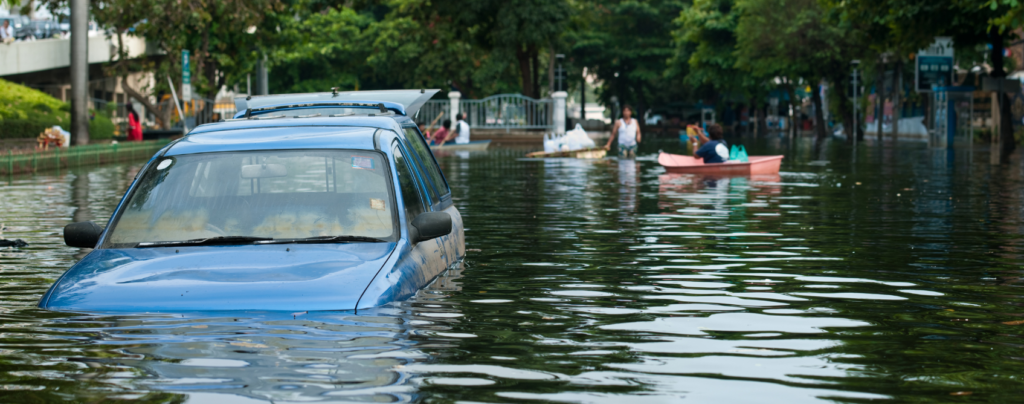
UN Secretary General Antonio Guterres spoke at the UN climate change conference (COP25) in Madrid on Dec 2nd, 2019:
“Do we really want to be remembered as the generation that buried its head in the sand, that fiddled while the planet burned?”.[4]
Do we? I hope not, for our children.
EARLY 2021 STATUS
In early 2021, our ability to limit the warming of the planet to only 1.5°C has very likely passed. Achieving drastic greenhouse gas emission reductions by 2030 is now down to 10 years; 30 years left to restore Nature to its pre-industrial beauty by 2050. With the clock ticking.
The Doomsday Clock, a symbolic representation of how close humanity is to destroying civilization, remains unchanged from its 2020 spot at 100 seconds (!) to midnight.[5] 100 seconds to midnight is the closest to midnight it has ever been – midnight marking the destruction of the world by our own making. The collective global failure to sufficiently address climate change is a major force to push the hands of the clock towards midnight.
The December 2020 UN Emissions Gap Report concludes that the world is still heading for a catastrophic temperature rise in excess of 3°C this century – far beyond the Paris Agreement goals of limiting global warming to well below 2°C and pursuing 1.5°C. The report states that a brief dip in carbon dioxide emissions caused by the COVID-19 pandemic will make no significant difference to long-term climate change.[6]
 A January 2021, Nature Climate Change article concluded that in fact carbon pollution already put in the air will push global temperatures to about 2.3°C of warming. Our committed warming based on all the greenhouse gases in the air may already be way beyond the Paris goal of below 2°C.[7]
A January 2021, Nature Climate Change article concluded that in fact carbon pollution already put in the air will push global temperatures to about 2.3°C of warming. Our committed warming based on all the greenhouse gases in the air may already be way beyond the Paris goal of below 2°C.[7]
The latest report by the UN Environment Programme in February 2021- Making Peace with Nature – lays out the gravity of Earth’s triple environmental emergencies – climate, biodiversity loss and pollution.[8] It concludes that unsustainable development is rapidly degrading Earth’s capacity to sustain human well-being; that the world is failing to meet its commitments to limit environmental damage; that these three emergencies need to be addressed together; that given current efforts we will certainly miss the Paris Agreement targets and that everybody has to do their part.
To prevent warming beyond 1.5°C, we need to reduce global GHG emissions by 7.6% every year from 2019 to 2030. In 2019 emissions still rose by 2.6% and although a COVID-19 pandemic-triggered global lockdown resulted in a brief dip in carbon dioxide emissions (-7%) in 2020, it will make no significant difference to long-term climate change. The year 2020 is likely to be the warmest on record, with wildfires, droughts, storms and glacier melts intensifying.[9]
Jennifer Francis, a senior scientist at Woods Hole Research Center (USA), an independent research organization that studies climate change, said that a 3.2 °C warming world would cause untold suffering.
“That’s what I worry about the most, the conflict and the misery that’s going to happen around the world,” she said. “That’s what keeps me up at night.” 10 – Jennifer Francis
Nobody will be excluded from this suffering; either people are directly affected by losing their homes or entire communities to environmental disasters such as wildfires, floods, storms or rising ocean levels, water and food shortages, failing crops, or indirectly affected by people mass-migrating to regions or countries that are – for the moment – better off. Social upheaval, conflict and wars will be unavoidable consequences of these scenarios. If people lose the basis of their existence – home, food, water, community, or safety, they will need to move on, to places that provide life’s essentials.
For many regions across the planet the suffering has already begun, triggered by the warming climate. A large and increasing number of people have lost their homes and communities to uncontrollable wildfires over these past summers: California, Western Canada, Australia, Europe, Russia, even the Pantanal, the Amazon and Southeast Asian Rainforests[10]. Hurricanes and floods are increasing in frequency and intensity[11], [12], safe drinking water supplies are drying up in many places (e.g. India[13]), and recurring crop failures and food insecurity are becoming the new norm.[14] Hundreds of people and millions of animals die in these events every year and it will get worse.
These vulnerable ecosystems and regions need more than casual 30-year government climate commitments to reduce greenhouse gases (at the risk of annihilation by the following administration), a midget fleet of electric or hydrogen-powered cars, installation of some triple pane windows and bringing your own shopping bag. These will not cut it.
CLIMATE ACTIVISM & GOVERNMENT COMMITMENTS
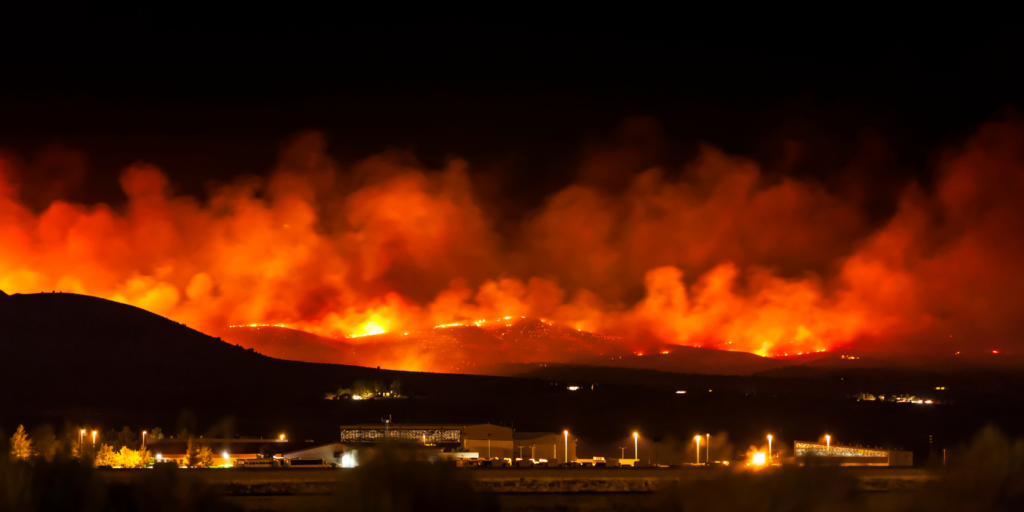
Activists and supporters of Fridays for Future, Extinction Rebellion and Greenpeace to name a few initiatives, do believe there is a serious problem. Masses take to the streets across the globe, demanding action on the climate crisis, accusing politicians and governments (own and foreign) of not doing enough, not acting quickly enough, not seeing the extent of the crisis, of ignoring scientists and their compelling evidence. Meanwhile countries have withdrawn from the Paris Climate Agreement, or have not ratified the agreement, other countries are not even signatories to it and of the participating nations many sit idle, not knowing where to start, what to do, what it means to their economy, whether climate change is real and truly consequential or not (a hefty wildfire season is quickly forgotten) and whether the scientists have gotten it right this time.
Some governments are starting to put climate change legislation in place, in most cases however it is not ambitious enough to achieve carbon neutrality by 2050 or there are no penalties in place if emission reduction targets are not achieved as we make our way to 2050.
New and significant pledges were made at the 2021 Earth Day on April 22, at a world leader event hosted by the USA. Many countries have actually pledged GHG emission reductions at around 50%, by 2030 – little attention however was paid to the details of how this will be achieved.
The March 2021 UNFCCC update on nations’ progress towards cutting emissions paints a bleak picture; their combined impact puts them on a path to achieve a less than 1 per cent reduction by 2030 compared to 2010 levels. This is in stark contrast to the 45% reduction needed to meet the 1.5°C temperature goal.[15]
A number of G20 countries have net-zero 2050 emissions goals: EU, France, UK, Japan, South Korea, Canada, South Africa, Argentina and Mexico; China by 2060. There are however significant inconsistencies between the emission levels implied by current policies and those projected under current “nationally determined contributions” by 2030, and, more importantly, those necessary for achieving net-zero emissions by 2050.[16] Basically, easy-to-write 30 year commitments and strategies versus hard-to-implement immediate emission reduction actions.
Canada for instance is taking its first unassertive steps in the areas of clean electricity, buildings, transportation, industry, forestry, agriculture and waste, short-lived climate pollutants (e.g. hydrofluorocarbons), methane regulations for the oil and gas sector, carbon pollution pricing, and clean fuel standards.[17] The European Union has laid out a Green Deal plan to become the first climate-neutral continent by 2050, focusing on zero pollution, affordable secure energy, smarter transport, and high quality food.[18] Some jurisdictions (states, provinces, territories) step up to legislate climate actions, even if the countries itself do not. The state of South Australia put the 2021-25 Climate Change Action Plan in place; it focuses on clean energy transformation, low emission transport, agriculture, climate smart cities and communities and economy.[19] South Korea pledged to become carbon neutral by 2050 and announced large investments to replace coal power generation with renewable energy, to replace old buildings and public rental housing with eco-friendly facilities and to put more than a million 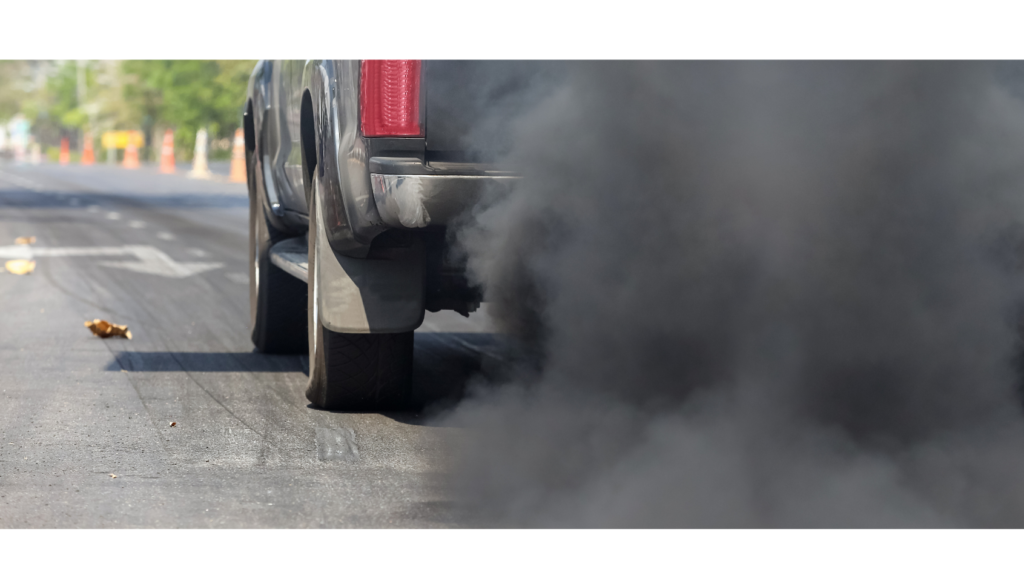 electric and hydrogen vehicles on the road.[20]
electric and hydrogen vehicles on the road.[20]
Tangible actions and binding legislation is less clear for some of the main GHG emitters, such as China (30% of global emissions) or the USA (15% of global emissions). Will all nations do their part, in time? Will they have the courage to start now, as is required to achieve the required 2030 and 2050 emission targets? The US$ 95 billion damages price tag for 22 major US weather and climate disasters in 2020 may trigger some actions.[21]
One can still hope for timely and consequential global government and perhaps even industry actions, but both are driven by short term concessions, election cycles and economic interests. Many countries act hesitantly or are in denial to act on climate change, fearing perceived economic disadvantages over its neighbors and “competitors”. Yet governments may not act assertive enough to turn off the greenhouse gas heater that drives us into a super-heated future, with consequences predicted but not yet universally felt across the planet.
Climate Change movements are loud, provocative and are on the streets or have activists suspended from structures. These peaceful, non-violent protests are important to grow public awareness and to mount political pressure, as large scale deforestation or fossil-fueled energy generation need governmental policy responses. These public campaigns are absolutely necessary and may eventually lead to lasting changes in policies but (un)fortunately they are only one part of the solution; only one side of the coin. Our time is running out.
We may think challenging elected officials, governments and multinational corporations into changing practices and policies is hard. There is an even harder challenge; every single one of us needs to change. This is the other side of the coin. We produce greenhouse gas emission; our own very actions do, every hour, every day. If we want a different outcome (<1.5°C of warming), we need to change our behaviors; we need to stop burning fossil fuels, directly (driving, flying) or indirectly (coal-based electricity, shipping of online purchases).
“Maybe it’s time we started addressing questions about limits and scale on human consumption” – Ann Dale, Director of the School of Environment and Sustainability at Royal Roads University in Victoria, Canada.22
We need to show governments, corporations, the world what we want – a stable climate, a better future, and restored nature. It is easy to blame others for not doing enough. It is hard to look at our own actions and conclude that they are equally disastrous. We need to lead by example.
Whodunnit?

Who is to blame for the current and still increasing levels of greenhouse gases in our atmosphere? Basically, everybody and their cows (main methane emitters) – around two-thirds of global emissions are linked to private households. Developed nations, in particular the most wealthy ones, bear the greatest responsibility. The combined emissions of the richest one percent of the global population account for more than the poorest 50 per cent.[22]
The richest 1% of the global population (income over $109,000 US in 2015) account for more emissions than the poorest 50%. This group will need to reduce its footprint by a factor of 30 to stay in line with the Paris Agreement targets.[23] The richest one percent was responsible for 15 percent of emissions from 1990 to 2015 – more than all the citizens of the EU and more than twice that of the poorest half of humanity (7 percent).
“The over-consumption of a wealthy minority is fuelling the climate crisis yet it is poor communities and young people who are paying the price.”, Tim Gore, Head of Climate Policy at Oxfam.[24]
The richest 10 percent (income over $38,000 US in 2015) accounted for over half (52 percent) of the emissions added to the atmosphere between 1990 and 2015. The richest 10 percent must slash emissions by 90 per cent and do it by 2030.[25] The world’s wealthiest and most powerful countries, the G20 nations, collectively account for 78 per cent of all emissions.[26] They need to reduce the most, the quickest. No way around it.
Who can and who cannot make changes?
Even within highly industrialized nations there is a large proportion of low income individuals and families and substantial layers of poverty. In any given population there is a spectrum of financial opportunities, abilities and choices. Some have everything and all choices, some have enough and plenty of choices, some have little and very limited choices and some have nothing and what seems no choices. In this global crisis that affects everyone, we need to provide opportunities for every individual to contribute, in a dignifying way, as a valuable citizen of our global community.
We need changes everywhere; but the ones who have more, who can afford more, who have more choices are asked to act first and boldest; to reduce their environmental footprint so others can live well in countries that experience the effects of climate change but have little choice in the matter. Don’t look to others to act first or along with you, it is time to act for everybody – and it is now. With time, an increasing number of people will enter a climate crisis mode; loss of homes, food, water, communities etc. The climate stress will have a toll on many who are suffering and who are watching. The mental health of people will decline at an accelerating pace. Once you are in this stress and crisis mode, voluntary change is almost impossible. The longer we wait, less and less people will have the ability to change.
2.1 tons of CO2 per person
By 2030 the annual per capita fossil fuel emission target is 2.1 tons!
- One long haul flight = 2.0+ tons CO2
- 4.0+ tons CO2 for driving one medium size car for 20,000 km/year
- Heating/cooling 5.0+ tons/year
The 2020 UN Emissions Gap Report states that around two thirds of global emissions are linked to private household activities and that lifestyle changes are a prerequisite for sustaining reductions in GHG emissions.[27] Most climate mitigation pathways that seek to keep temperature rise to within 1.5°C envisage a major role for lifestyle change. The International Energy Agency has likewise concluded that behaviour change is an integral part of emissions reduction strategies that accomplish net-zero emissions by 2050, emphasizing in particular the need for changes to domestic energy use, as well as reductions in car use and passenger aviation.[28]
According to the UN report, each global citizen has a per capita consumption emissions target of 2.1 tons of CO2 by 2030 to limit warming to 1.5°C. 2019 data shows global average per capita CO2 emissions at 4.7 tons (t), topped by the US with 16.1 tCO2 per capita (Canada 15.4, Russia 11.5, Chine 7.1, EU 6.6, India 1.9).[29] We have a long way to go to meet the annual per capita 2.1 tCO2 goal.
 For comparison, a London (UK) – Los Angeles (USA) return flight generates 1.7 ton CO2, London-New York 1 tCO2, London – Perth (Australia) = 3.2 tCO2, per passenger. With a 2.1 tCO2 annual budget, these flights are unjustifiable going forward. These figures highlight the disproportionate carbon footprint of those who can afford to fly, with even a short-haul return flight from London to Edinburgh (118 kg CO2 per passenger) contributing more CO2 than the mean annual emissions of a person in Uganda or Somalia.[30]
For comparison, a London (UK) – Los Angeles (USA) return flight generates 1.7 ton CO2, London-New York 1 tCO2, London – Perth (Australia) = 3.2 tCO2, per passenger. With a 2.1 tCO2 annual budget, these flights are unjustifiable going forward. These figures highlight the disproportionate carbon footprint of those who can afford to fly, with even a short-haul return flight from London to Edinburgh (118 kg CO2 per passenger) contributing more CO2 than the mean annual emissions of a person in Uganda or Somalia.[30]
A typical passenger vehicle emits about 4.6 tons CO2 per year; based on 11,500 miles/yr (19,000 km) and an average fuel economy of 22 mpg (13 l/100km).[31] Emissions go up to 9 tons and more per year for large SUVs and trucks.
Globally, one third of all food produced for human consumption is wasted – more than a billion tons annually.[32] In Canada, for instance, a study by Second Harvest shows that 58% of all the food produced is lost or wasted (36 million tons). Households account for 5 million tons (14%) along this food waste chain. As a result, every year 56.5 million tons of CO2 equivalent emissions are created by food waste in Canada.[33]
In the European Union, 61% of all road transport emissions are from passenger cars (next in line heavy duty trucks with 26%).[34] In the US, the transportation sector generates the largest share of greenhouse gas  emissions (28%). Passenger vehicles (incl. pickup trucks, SUVs and minivans) account for more than half of these emissions (59%).[35]
emissions (28%). Passenger vehicles (incl. pickup trucks, SUVs and minivans) account for more than half of these emissions (59%).[35]
Add heating and cooling our homes and everything that we consume that needs to be produced, packaged and shipped, we as individuals have a huge impact on GHG emissions and hence an equally huge potential and responsibility to reduce them – start with minus 50%.
Some may argue that a positive framing of the required actions would be better; to stress positive attributes and to do more of the positive things that are in line with healing the environment and all living beings. Yet, given the urgency of the situation and for quick impact, we need to stop doing certain things (by 50%) and allow sustainable, healthy and climate stabilizing actions to fill the void as time passes. Out of reducing harmful behaviors, positive traits and actions will arise.
minusfiftypercent – THE MOVEMENT

Climate change is real and even if it wasn’t, it is time for a major change in the world towards sustainability, environmental protection, peace, equality, community, purpose and meaning.
Who is driving up greenhouse gases in our atmosphere? People – I. You. Us. Convenience, habits, ignorance, entitlement (wealth), disrespect and a lack of love for self and others, including the environment and all living beings on earth.
We are the cause for the climate crisis- every single one of us. And we need to be the solution.
As it stands now, governments and industries are acting hesitantly or are not acting at all. Yet, it is our collective future that is at stake, our quality of life, our survival. We, the citizens of the world need to act courageously and lead the way. Governments and industries will be forced to follow. And the biggest polluters among us (i.e. the wealthiest[36]) need to cut their emissions the most.
The task ahead is gigantic. No lying about it. There is no immediate reward, motivated by our grand-grand children’s quality of life. One has to trust science and one’s own guts. Switching to an electric vehicle today will not result in less wildfires next year, but help enable that there will still be forests that have not burned to the ground in 100 years.
Truly understanding the science behind climate change and making sense of carbon emission data (e.g. what is the meaning and impact of a ton of CO2 equivalents?) is almost impossible. One can get lost in potential conflicting data and calculations (e.g. emissions from driving or flying, impact of meat consumption or purchasing of goods), leading to jadedness, resignation and inaction. It is as much about emission calculators as it is about a felt sense of doing the right thing. Simply, switching your internal combustion engine vehicle for an electric vehicle will reduce your GHG emissions by 4-10 tons of CO2, reducing your flying will save 0.5-10+ tCO2 depending on frequency and distance. Add heating/cooling (2-10 tCO2), meat consumption (frequent beef & lamb meals add up to 2 tCO2/year) and other goods (production, packaging and shipping – 1-10 tCO2). These can add up to an average of 16 tons of CO2 for US citizens, 15t for Canadians or 7t for Europeans[37].
What is needed is a simple formula, such as cutting your emissions in half. minusfiftypercent is an invitation towards a carbon-neutral, sustainable future – minusfiftypercent.org.
The time for big, bold, grassroots, and people-driven action has come; at a rate of minusfiftypercent. Reduce all your fossil-fuel powered, wasteful, unsustainable, polluting and socially damaging activities by fifty percent. Once achieved, stabilize and do it again, shave off the next 50%, until we are all at zero emissions. And start today.
minusfiftypercent – it is our personal choice to participate. It is free, yet has an extraordinary cost. The cost associated with changing our habits and behaviors; relinquishing certain conveniences and felt entitlements; leaving our comfort zone and putting our money where our heart is. The individual price paid now, does not compare in magnitude to the cost born by our children, grandchildren and all future generations (i.e. food and water security, conflicts, wars, mass migration, and (mental) health). On a global level, mitigating climate change and restoring the planet for thriving future generations has of course a quite significant cost (1.0 – 2.2% of the global GDP – billions of dollars).[38],[39]
The question we have to individually answer is whether our own current pain, the pain observed in others and the predicted pain inflicted by a 2+ degree Celsius warmer planet is significant enough to make substantial changes to our own lives right now.
The challenge with these required changes is the dilemma of no immediate rewards. How to get started and stay motivated when the reward is a better future in 30+ years’ time (e.g. 2050 and beyond). How can we find joy and be intrinsically motivated in our new way of being. How can we overcome the feeling of losing out and being disadvantaged when cutting our driving, flying and overall consumption? Our friends and neighbors all drive big trucks, fly around and have all these (fun) tools and gadgets. How can we find peace and joy in making different choices going forward and sustain them.
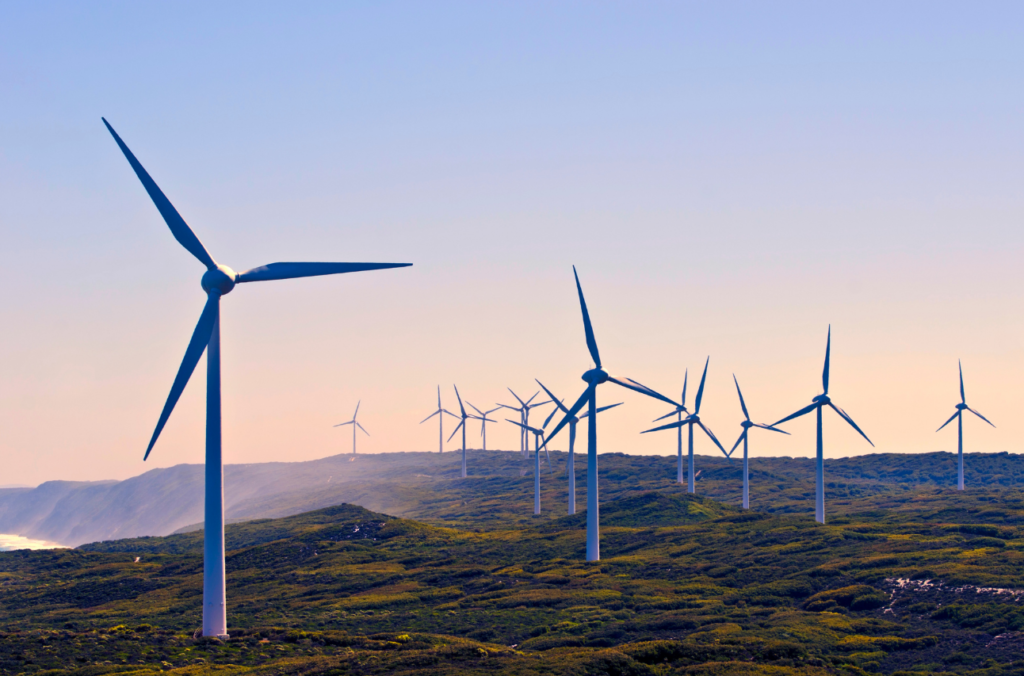 Intrinsic motivation is defined as the act of doing something without any obvious external rewards. You do it because it’s enjoyable and interesting, rather than because of an outside incentive or pressure to do it.[40] Changing our behaviors must come from this place of inner motivation. The external reward of a restored balanced climate by 2100 is too theoretical. We have to find within ourselves the ‘pure joy of not’. Not driving but carpooling/walking/cycling; not buying new stuff (make due without that new phone or piece of clothing); not flying for pure pleasure, but staying local; not being on screens (social media, TV) all day long, but connecting to nature; not eating meat every day but enjoying a more plant-based diet. We need to reduce our impact for good.
Intrinsic motivation is defined as the act of doing something without any obvious external rewards. You do it because it’s enjoyable and interesting, rather than because of an outside incentive or pressure to do it.[40] Changing our behaviors must come from this place of inner motivation. The external reward of a restored balanced climate by 2100 is too theoretical. We have to find within ourselves the ‘pure joy of not’. Not driving but carpooling/walking/cycling; not buying new stuff (make due without that new phone or piece of clothing); not flying for pure pleasure, but staying local; not being on screens (social media, TV) all day long, but connecting to nature; not eating meat every day but enjoying a more plant-based diet. We need to reduce our impact for good.
Our reward is knowing that we are doing the right thing – for the future. We may feel punished and disadvantaged, angry at others who still pollute, who still drive and fly, eat strawberries in the middle of winter and simply don’t care. It may look like they are better off and we suffer from having or doing less. Yet, our cooperative nature (for the common good and our children) must prevail over our cheating nature (they do it too). There will be a tipping point however, when it is no longer socially acceptable to drive a ginormous truck to the grocery store to get a carton of milk. The judgement will be reversed; from condescending smiles for those early climate change and minusfiftypercent adopters to evil stares for the polluters.
Be “self-punishing” now or be finger-pointed and/or punished later. These changes will be required to mitigate climate change, either voluntarily now or dictated soon. Changing our habits and accepting inconveniences is free and our choice. There are tangible benefits too: cost savings (spending and consuming less), satisfaction through positive action, and stronger relationships and communities. It can be hugely rewarding for us individually, our families and communities and of course the planet itself.
 We as individuals must stop doing certain things and expand it, if possible, to our immediate environment (family, friends, organizations and small businesses). Given most people’s life circumstances, it is often impossible to do a full stop on certain activities (minus 100%), but going forward climate-smart decisions need to be a priority – at all times, for all decisions. Therefore, let’s start with cutting those polluting and wasteful behaviours in half (minus 50%). Never again is too daunting, reducing by half can be OK. Who would choose to never fly again, completely stop eating beef/becoming vegetarian/vegan, throw out the TV (and all other screen gadgets), never use any plastic bags/products anymore or get rid of all cars and go completely green. Not many. Likely no one.
We as individuals must stop doing certain things and expand it, if possible, to our immediate environment (family, friends, organizations and small businesses). Given most people’s life circumstances, it is often impossible to do a full stop on certain activities (minus 100%), but going forward climate-smart decisions need to be a priority – at all times, for all decisions. Therefore, let’s start with cutting those polluting and wasteful behaviours in half (minus 50%). Never again is too daunting, reducing by half can be OK. Who would choose to never fly again, completely stop eating beef/becoming vegetarian/vegan, throw out the TV (and all other screen gadgets), never use any plastic bags/products anymore or get rid of all cars and go completely green. Not many. Likely no one.
Never again and stopping completely is too hard and will prove unrealistic and unsuccessful. (Some things such as the use of single use plastics and idling of cars actually need to be eliminated/reduced by 100%).
We also have to act to preserve certain joys that we have now, such as enjoying snow for winter sports. The annual snowfall has steadily declined and will continue to decrease.[41] Driving V8 Diesel trucks loaded with snowmobiles is actually a piece in the climate puzzle causing the decline of annual snowfalls.
If your electricity is produced by burning coal, every KWh not consumed has a direct emission impact. But even if electricity is generated through renewable sources, who wants to drive through forests of solar panels or wind turbines, rather than actual trees. Hydroelectric dams are environmentally destructive as well. We don’t want to build any more. Using less is the answer.
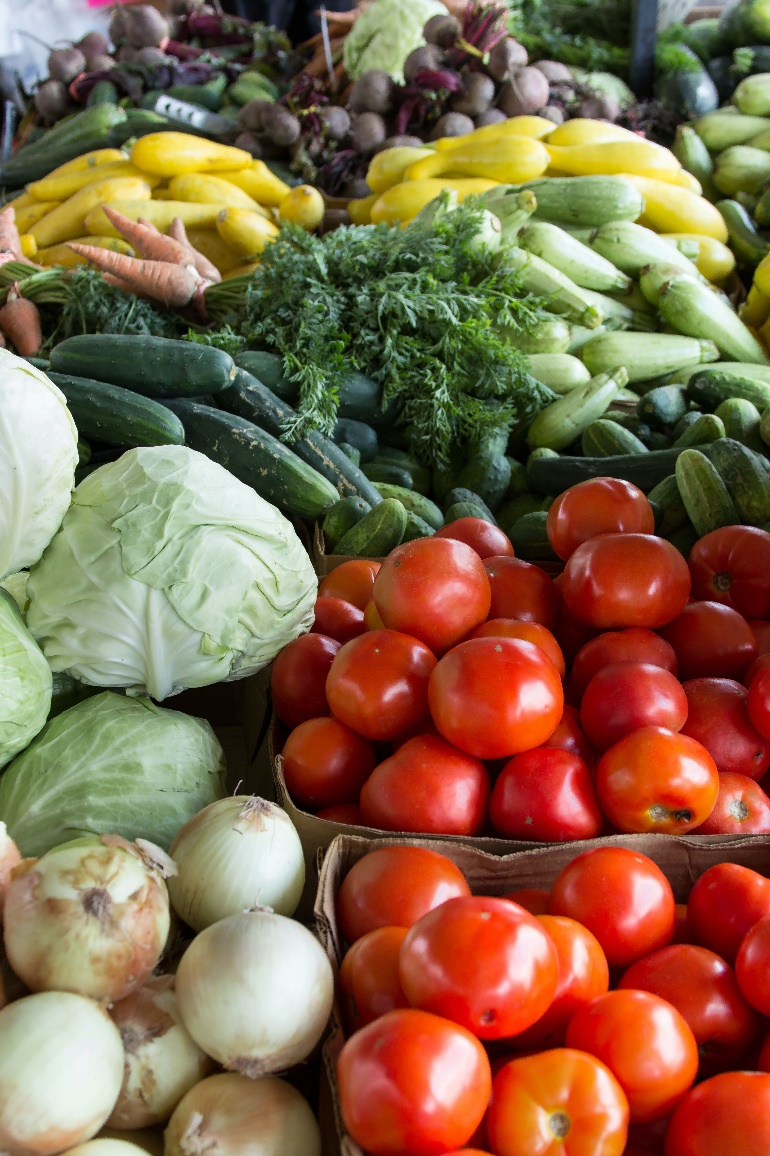 Researchers and organizations are starting to make projections on what will happen if all go vegetarian overnight or stop flying.[42],[43] The reduction of GHG emissions would be fantastic, yet it is undoable and the societal disruption would be equally unbearable with regards to job loss and suffering (e.g. meat processing from ranching, packaging to transport; airlines). A global stop of anything is unthinkable – at least at the moment. What we need is a substantial shift; the biggest polluters and consumers, individually and by country need to act first and boldest – minusfiftypercent.
Researchers and organizations are starting to make projections on what will happen if all go vegetarian overnight or stop flying.[42],[43] The reduction of GHG emissions would be fantastic, yet it is undoable and the societal disruption would be equally unbearable with regards to job loss and suffering (e.g. meat processing from ranching, packaging to transport; airlines). A global stop of anything is unthinkable – at least at the moment. What we need is a substantial shift; the biggest polluters and consumers, individually and by country need to act first and boldest – minusfiftypercent.
For many large-scale, systems-wide or even global change initiatives it is often challenging to measure the impact. Luckily, not for GHG concentrations in the atmosphere. There are already sophisticated ways in place to measure the concentration of CO2, methane, nitrous oxide or fluorinated gases in the atmosphere. At least on a global scale, we will know if these concentrations are coming down; if our collective actions have an impact.
Individually, we need to set our own goals; determine our baseline and start “minusfiftypercent-ing it”. There are plenty of tools and calculators to support our journey.[44],[45],[46] The Intergovernmental Panel on Climate Change is giving us our personal target: 2.1 tons of CO2 emissions per person by 2030!
What to do? What to change? Where to start?
The proposed minusfiftypercent list of tangible changes is not entirely new: automobile and air travel, energy and food consumption, and out of hand consumerism. Yet, the desire to adopt these changes need to come from a deep place within us and hence need to be coupled with social transformation: our connection to and relationship with nature, our addictions to screen, money/debt, spirituality, education, and health/mental health. In short, our own and collective value systems.
What inspires you? What are you able/willing to reduce, now and into the future? Collectively, we will have a tremendous impact, changing the landscape of what is possible.
The BIG 5
A minusfiftypercent mindset, addressing the 5 categories in Table 1 below, adopted by a significant number of people, will shake up some industries. Consumerism will decline, with a reduced need for producing a wide array of consumer goods, especially non-essential gadgets. A steep decline in fossil fuel needs from reduced travel and industrial consumption will impact the entire oil/gas (& coal) sector, from exploration to gas stations and the petrochemical industry.
Table 1
CATEGORY |
What to reduce by 50% |
Replace with |
|
Travel |
All driving and flying (4-30+ tons CO2 equivalents per individual/family) |
Walk, cycle, public transport, car share, carpool, home office, electric transport |
Details – TRAVEL |
Energy Consumption |
Heating/cooling & electricity use (2-10+ tons CO2 equivalents per individual/family) |
Energy efficient homes, energy consciousness, reduce and conserve |
Details – ENERGY |
Food |
Red meat & dairy, high environmental impact, food waste (0.5-2+ tons CO2 equivalents per individual/family) |
Local, organic, in-season, plant-based, grow your own, don’t waste any food |
Details – FOOD |
Consumerism |
All new & online purchases, single use and over-packaged items, garbage (1-10+ tons CO2 equivalents per individual/family) |
Consciousness of what one really needs, re-use, buy used, share with others, no single use items, be informed, advocate for and demand alternatives, accept inconveniences |
Details – CONSUMERISM |
Social Transformation |
Screen time (!), debt, dependencies, addictive behaviors / habits, health issues & stress |
NATURE EXPERIENCES! Time in nature and with family & friends, spiritual connections, meditation, Yoga, nature-based & wholesome education for our children, purpose & meaning, joy of simplicity |
Details – SOCIAL TRANSFORMATION |
A taste of what this can look like was provided in the Spring (March/April) of 2020 amid the COVID-19 epidemic; oil prices plummeting, thousands of flights cancelled, Chinese industrial production scaled down significantly due to entire cities being in virus lock-down state. Stock markets collapsing and going into
automatic shut down. These were severe cuts to our societies and economies. Many jobs were lost and many still live with the fear of losing their jobs until the pandemic is declared over.
minusfiftypercent provides a more gradual adjustment to a new normal; a new normal with less oil, gas and coal consumption, less consumerism, more informed consumer choices, and the avoidance of societal breakdowns due to climate catastrophes, including more conflict and wars. Current jobs in unsustainable industries will be lost and there is no way around it. The truth is, we simply cannot afford to continue burning coal, oil and gas. It will hit many individuals and families very hard, but these industries and jobs are past their expiration date. However, workers and skills will be needed in our new sustainable, green economy. Jobs will transfer from fossil fuels to green. To enable this is the job of our governments – start lobbying now.
COVID-19 LESSONS LEARNED
In early 2020 the world shut down, due to a spreading respiratory virus pandemic. In early 2021 it is still shut down – in many regions even more than a year ago. Governments around the world took action and put rules and legislation in place to mitigate the spread of the virus; borders closed, flights grounded, mobility and social interaction restricted, businesses closed, making masks mandatory, and mobilizing relief funding for individuals and businesses.
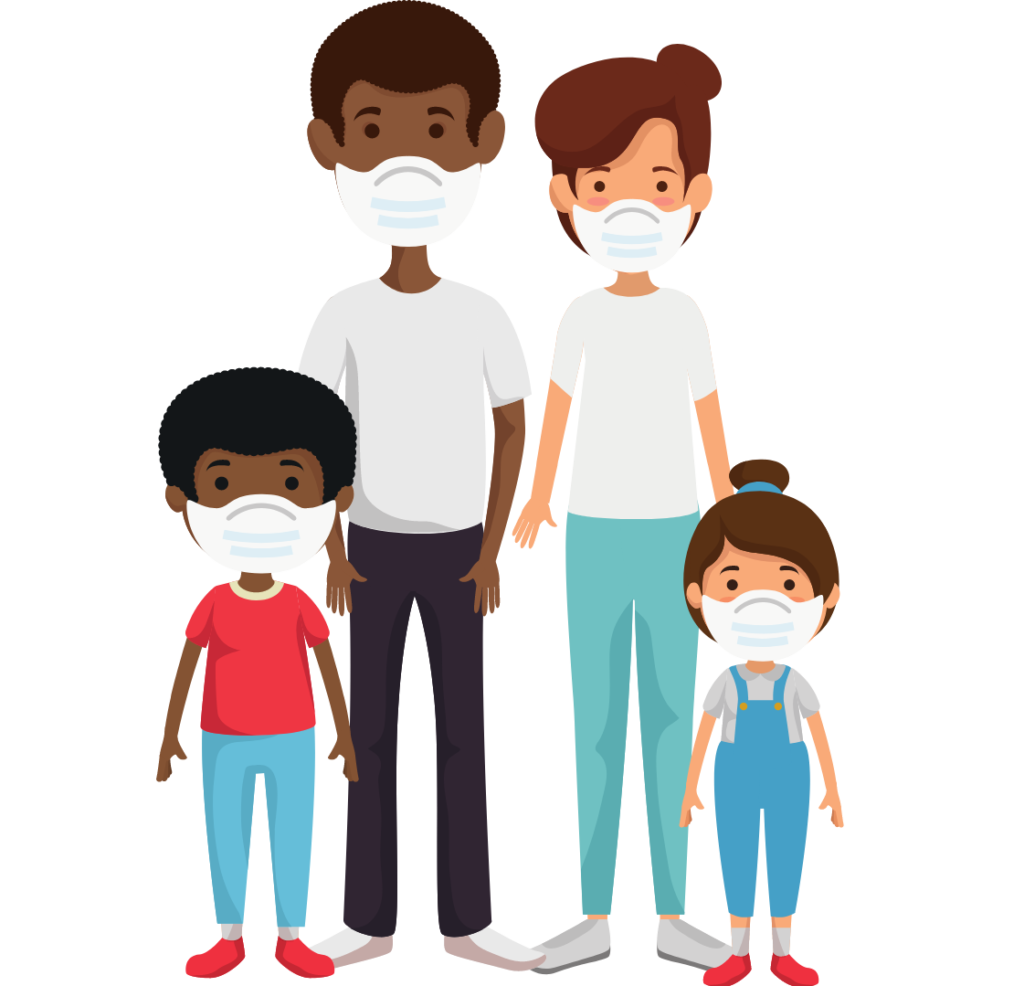 Look hard at what has happened during the 2020 pandemic. It will happen again when the effects of our climate crisis come to a boiling point. Emissions will need to be curbed, at all costs, similar to curbing COVID-19 infections. “Bending the curve” a widely used pandemic term to reduce virus infections will once again be common language, as we need to bend the GHG emissions curve. Governments will step in again and regulate individual behaviors and industries, via disincentivizing taxation (everything oil, gas & coal = carbon tax) or subsidized incentives (e.g. green energy technologies, electrification of transport). No one will like it. We will see the same resistance against climate measures as we have seen with pandemic measures, such as physical distancing, masks or vaccinations. Over time the use of SUVs and trucks will be restricted or they are heavily taxed that no one will buy them anymore. Some may remember the 1970s oil crisis, when most of the world faced substantial petroleum shortages – the governments stepped in and restricted driving; car-free Sundays and cars could not be used on specific weekdays. These measures will come back and more.
Look hard at what has happened during the 2020 pandemic. It will happen again when the effects of our climate crisis come to a boiling point. Emissions will need to be curbed, at all costs, similar to curbing COVID-19 infections. “Bending the curve” a widely used pandemic term to reduce virus infections will once again be common language, as we need to bend the GHG emissions curve. Governments will step in again and regulate individual behaviors and industries, via disincentivizing taxation (everything oil, gas & coal = carbon tax) or subsidized incentives (e.g. green energy technologies, electrification of transport). No one will like it. We will see the same resistance against climate measures as we have seen with pandemic measures, such as physical distancing, masks or vaccinations. Over time the use of SUVs and trucks will be restricted or they are heavily taxed that no one will buy them anymore. Some may remember the 1970s oil crisis, when most of the world faced substantial petroleum shortages – the governments stepped in and restricted driving; car-free Sundays and cars could not be used on specific weekdays. These measures will come back and more.
The 2020 COVID-19-associated decline in global fossil fuel emissions will only have a negligible impact in terms of climate change. Atmospheric CO2 continues to rise, and fossil fuel emissions will remain the principal driver of this growth.[47]
 Carbon dioxide emissions are predicted to fall up to 7% as a result of the pandemic slowdown. But this dip only translates to a 0.01°C reduction of global warming by 2050.[48] Only a temporary unsustained dip in the emissions curve with no real consequence. The World Meteorological Organization (WMO) described the projected COVID-19-related 2020 GHG drop as a “tiny blip”. They concluded that the resulting impact on the carbon dioxide concentrations that contribute to global warming would be no bigger than normal annual fluctuations.[49] The world shut down and it had no impact on our changing climate. Our societies, economies and lives are structured in ways that even when nobody drives or flies for almost an entire year, our fossil fuel emissions are still rocket high.
Carbon dioxide emissions are predicted to fall up to 7% as a result of the pandemic slowdown. But this dip only translates to a 0.01°C reduction of global warming by 2050.[48] Only a temporary unsustained dip in the emissions curve with no real consequence. The World Meteorological Organization (WMO) described the projected COVID-19-related 2020 GHG drop as a “tiny blip”. They concluded that the resulting impact on the carbon dioxide concentrations that contribute to global warming would be no bigger than normal annual fluctuations.[49] The world shut down and it had no impact on our changing climate. Our societies, economies and lives are structured in ways that even when nobody drives or flies for almost an entire year, our fossil fuel emissions are still rocket high.
The 2019 UN Environment Programme report states that unless global greenhouse gas emissions fall by 7.6 per cent each year (note, each year!) between 2020 and 2030, the world will miss the opportunity to get on track towards the 1.5°C temperature goal of the Paris Agreement.[50]
Just to say it again: the world shut down in 2020 due to a viral pandemic and the GHGE reductions (-7%) were not even meeting the required target (-7.6%). Rebounding of a fossil fuel-based economy after the global lockdown may just nullify these meager 2020 gains.
We have a choice now, widespread voluntary change of behavior now or 1) a 3.2°C warmer planet, which in fact we can not even start imagining or 2) severe COVID-style government restrictions that will be met with fierce resistance and more conflicts. This is our choice.
There are a few major differences between the COVID and Climate crises: during the COVID lockdown, the food, water and energy supply chains, together with all infrastructure were kept intact. Production of goods was reduced but did not entirely stop. Education and health care systems continued to operate. If you had a home, you did not necessarily lose it. Most people kept their jobs or got some form of government support. Everybody stayed put, nobody moved. COVID isolated individuals, countries and continents from each other, everything was going inward. Pandemic conflicts concentrated on mask and vaccination policies and were not driven by the most severely affected group, our vulnerable seniors (primarily in care homes). The risk of war was minimal. It was clear that the situation will get better – these were only short-term measures. The entire world worked on vaccines; science and pharma delivered within 12 months – at least to the wealthy countries that can afford them.
The climate crisis will almost be the exact opposite of the above: everything will be disrupted – food, water, infrastructure, production, energy production, loss of homes and jobs and increased migration and wars. Climate conflicts will be severe, as they will be about survival, affecting everybody.
COVID overwhelmed many health care systems, mainly the availability of hospital and ICU beds and ventilators. Elective surgeries were cancelled, people stayed away from doctors and emergency rooms to not burden the
system but also to not catch the virus. Climate Change will disrupt everything from food, health, shelter and most importantly, hope. No sophisticated quick-fix, next-generation vaccines available.

We will need to dig deep to find and sustain our hope in the midst of a decades/century-long climate crisis – it took us 100+ years to get here and we will need 100+ years to reverse our actions and to reduce GHGs in our atmosphere. 100+ years is a long time, as compared for 12 months for a COVID-19 vaccine. All climate change actions that will be put in place need to be permanent. And to be effective they will be mandated and enforced by governments – same as with the COVID sanctions. Everything that will be put in place is there to stay, forever.
The historic post-COVID restart as an unique chance to re-think how the world operates may in the end not play out. Countries are on different recovery trajectories, depending on severity of infections, virus variants and vaccine rollout. A global date of “post-COVID restart” will not exist. Instead, a gradual slip to pre-COVID consumerism, ignorance and exploitation of the plane is very likely.
What is asked of us, as brothers and sisters, to enter a post-COVID world with heart and the future in mind?
minusfiftypercent – BENEFITS, SOLUTIONS AND HEALING
Less Wins!
Drive Less
Fly Less
Use Less Energy
Eat Less Red Meat
Buy Less
Screen Less
(Fart Less – if you are a cow)
What are we truly trying to achieve? A healing of the climate, a healing of the world; a healing of people, a healing of our families and communities and healing ourselves. Although restoring/healing the climate is front and center, the healing stream actually works in the opposite direction: start with SELF, family, close relationships, community, world, and end with CLIMATE.
The climate is the anchor; but it is obvious that without the necessary social changes and a shift in values, nothing will change and the planet will burn.
The benefits of minusfiftypercent changes
Although some (all) of these required changes to our daily lives may seem as a big step back (giving up things), a burden, a nuisance, forced and unwelcome, there is a shining silver lining in them: we will experience significant cost savings by curbing our total consumption, revisiting our transport habits, or have zero food waste; we can restore our communities and relationships by shopping local and not online; our health can substantially improve through better air quality, a healthier, plant-based diet and increased levels of exercise (walking, cycling); natural spaces in our neighborhoods will improve as we start valuing and protecting them; our mental health will improve by spending more time in nature and less in front of screens; rediscovering or strengthening spiritual connections to our natural environment may be very rewarding; these changes will reduce our overall stress levels.
minusfiftypercent ENABLERS
Awareness
 Many of us get on with our days, minding our own business and struggles, often taking the easy way out; life is complicated enough as it is. Many conveniences and distractions are offered to make life easier and more time-efficient: e.g. single-use plastics, use of our own car, don’t bother with recycling, take out meals & containers, fly to the sun to leave our stresses behind, (more) screen time etc.
Many of us get on with our days, minding our own business and struggles, often taking the easy way out; life is complicated enough as it is. Many conveniences and distractions are offered to make life easier and more time-efficient: e.g. single-use plastics, use of our own car, don’t bother with recycling, take out meals & containers, fly to the sun to leave our stresses behind, (more) screen time etc.
We have to wake up. We have to become acutely aware how our own very actions impact greenhouse gas emissions and our climate: how much we drive and fly and why; what we eat and where it comes from – how it was produced and how much we waste; how much we buy and why – distinguish needs from wants; how we value nature or not; how much we are addicted to screens, social media or substances and why; what are we doing out of convenience and how can we change that?
It is through our individual and collective awareness that we can change our climate, environmentally but also socially destructive behaviors.
We also have to be very mindful of the ability and capacity of each individual to change, given our individual life circumstances. Some have more ability to change than others, given their income, social status or where they live. Yet it is only fair to create opportunities to contribute, for everyone.
Nature
 What we do not value, we do not protect. We need to go back to spending more time in nature; engage in human-powered activities such as walks, runs, hikes, bike rides, kayaking, canoeing, gardening, camping, ski/board or cross-country ski; find something that inspires you and do it. Once we again feel connected with nature, with rivers, mountains, lakes, beaches, oceans and forests, we will value and protect them. We will preserve the pristine beach we are standing on – keep it free of plastic water and pop bottles. We will stand up, we will take individual action to not lose all of it to pollution, flooding or destructive wildfires.
What we do not value, we do not protect. We need to go back to spending more time in nature; engage in human-powered activities such as walks, runs, hikes, bike rides, kayaking, canoeing, gardening, camping, ski/board or cross-country ski; find something that inspires you and do it. Once we again feel connected with nature, with rivers, mountains, lakes, beaches, oceans and forests, we will value and protect them. We will preserve the pristine beach we are standing on – keep it free of plastic water and pop bottles. We will stand up, we will take individual action to not lose all of it to pollution, flooding or destructive wildfires.
We need to wrestle ourselves away from the television and other screens. Take yourself and your family out into nature to experience the beauty, calm and healing that is available at natural places. Get away from cities as often as you can. See the stars and wonder what is beyond our CO2-laden atmosphere. Stand on a mountain top and look around, be amazed, be humble – and hopefully it is not during a wildfire season where dense widespread smoke blocks out all views.
We have to inspire our children to love nature; to care for plants and animals of all sizes. Create a garden, grow your own food, get them into the dirt, let them experience the rawness and beauty of nature. We have to model it for them – we have to love nature, not merely pretending we do. We need to find or re-discover our own spiritual connection with the natural world.
Community
 Many countries and societies across the planet face an erosion of community; a loss of a deeply felt sense of belonging, safety, support, shared values and friendship. The COVID-19 pandemic has increased the speed and intensity of social isolation. Social media and free video calling Apps help mitigate some of the isolation and provide meaningful connections but the erosion of community values runs a fast pace. Social media in particular often drives isolation, despite the feeling of being connected to a large group of people. The mental health of everybody across the age continuum is declining; of deep concern are the mental health challenges observed in our children and youth.
Many countries and societies across the planet face an erosion of community; a loss of a deeply felt sense of belonging, safety, support, shared values and friendship. The COVID-19 pandemic has increased the speed and intensity of social isolation. Social media and free video calling Apps help mitigate some of the isolation and provide meaningful connections but the erosion of community values runs a fast pace. Social media in particular often drives isolation, despite the feeling of being connected to a large group of people. The mental health of everybody across the age continuum is declining; of deep concern are the mental health challenges observed in our children and youth.
We need to find back together as communities – only in some cases as online communities – to find ways to be in close relationship with each other; our neighbors, co-workers, church groups, through schools / colleges, sports, hobbies etc. We need to build networks of trust so we can organize carpools, borrow and lend tools, purchase things together and share, rather than everyone buying everything themselves. Carpool to work and school. Offer ride-shares within your network; take the bus, walk, or cycle together.
This is more fun as well. Trusted relationships are great boosters to our positive outlook on life. It is inspiring, we support each other, we have fun together, we save money and protect the climate and our environment. We need to establish healthy trusted relationships.
Heart
 We have to find our heart, for each other and all living beings on the planet. There is no other way to combat climate change and all our social issues that led to it. The mind can only take us so far – the depth of the heart however is fathomless. The necessary social renewal will not be a mind game but be powered by love, open hearts and shining souls.
We have to find our heart, for each other and all living beings on the planet. There is no other way to combat climate change and all our social issues that led to it. The mind can only take us so far – the depth of the heart however is fathomless. The necessary social renewal will not be a mind game but be powered by love, open hearts and shining souls.
The behavioral changes that the minusfiftypercent movement is asking from every single individual need to be fueled by our internal motivation – change for the sake of avoiding suffering for others, especially our children. Governments will eventually dictate the necessary changes and they will be resisted, further delaying necessary actions. Let’s reach into the depths of our cores and ignite a fire that shines brightly into the future sustained by our intrinsic motivation to change the future for our children and all future generations. To restore a healthy and beautiful world.In the end, it will be our hearts that determine our future. Let’s grow our potential for openness, love, connection and relationships. This is how greenhouse gases will be reduced and social renewal will be achieved.
This is what needs to happen. Not newest, not biggest, not coolest, not most expensive – Zero Emission wins! “Not” wins!
We have 10 years left to the end of December 2030. Let’s see what achievements we can celebrate on New Year Eve of 2030. It is our choice to act. I hope you will.
For more details and information please visit: minusfiftypercent.org
Photo Credits: Canva & Pexels
About the Author
 Julius Halaschek-Wiener, PhD, creator of the minusfiftypercent movement, a past scientist himself (genetics/genomics, cancer cell biology & healthy aging), has confidence in the scientific conclusions of the international panel of climate scientists. He believes that we individually must change; not merely to pretend or tinkering at the edges. He also recognizes that a total stop is also not possible. Therefore, the goal is to start with a -50% reduction of polluting and harmful behaviors and once achieved keep “minusfiftypercent-ing it“, as much as you can.
Julius Halaschek-Wiener, PhD, creator of the minusfiftypercent movement, a past scientist himself (genetics/genomics, cancer cell biology & healthy aging), has confidence in the scientific conclusions of the international panel of climate scientists. He believes that we individually must change; not merely to pretend or tinkering at the edges. He also recognizes that a total stop is also not possible. Therefore, the goal is to start with a -50% reduction of polluting and harmful behaviors and once achieved keep “minusfiftypercent-ing it“, as much as you can.
Julius follows a life-long pursuit of simple, green and sustainable living, holistic health and well being. He lives with his family in rural British Columbia, Canada. What does their life look like: added a used 2014 Nissan LEAF in March 2021 ( for all short trips) to their 2006 Subaru Forester (longer trips & camping/logging roads/extreme winter conditions); wood stove heating (90%) & natural gas (10%); gardening for own food, incl. eggs; buying local and organic; every possible piece is recycled (incl. going through the garbage at work meetings – at a time when in-person meetings were still a thing); tirelessly looking at ways to reduce  their carbon footprint (carpool, cycle, reduce electricity use, house energy upgrades); buying used (clothing, bikes, tools); being in nature; keeping screen time low (very hard!) and limiting online purchase to items (or their alternatives) that are truly needed and not available locally. Julius served on the board of the Nelson Waldorf School for many years as he strongly believes that Waldorf education balances engaging students’ heads, hearts and hands, helping educate the bright, grounded, earth-connected and creative leaders our world desperately needs.
their carbon footprint (carpool, cycle, reduce electricity use, house energy upgrades); buying used (clothing, bikes, tools); being in nature; keeping screen time low (very hard!) and limiting online purchase to items (or their alternatives) that are truly needed and not available locally. Julius served on the board of the Nelson Waldorf School for many years as he strongly believes that Waldorf education balances engaging students’ heads, hearts and hands, helping educate the bright, grounded, earth-connected and creative leaders our world desperately needs.
Emitted 6.08 tons of direct CO2 equivalents, as a family of 4, in 2020 (2.12 t CO2e for heating/hot water & 3.91 t CO2e for running the car; 2x 20lb BBQ/camping propane tanks <0.048 tCO2), plus unknown indirect emissions from food (meat) and other purchases (transport, packaging etc).
To contact Julius please email: minusfiftypercent@gmail.com
REFERENCES
-
Scientific Consensus | Facts – Climate Change: Vital Signs of the Planet ↑
-
Secretary-General’s remarks at opening ceremony of UN Climate Change Conference COP25 [as delivered] ↑
-
CO2 already emitted will warm Earth beyond climate targets, study finds ↑
-
India has just five years to solve its water crisis, experts fear ↑
-
South Australian Government Climate Change Action Plan 2021 – 2025 ↑
-
South Korea formally commits to cutting emissions to net zero by 2050 ↑
-
Record number of billion-dollar disasters struck US in 2020 ↑
-
Carbon emissions of richest 1 percent more than double the emissions of the poorest half of humanity ↑
-
Carbon emissions of richest 1 percent more than double the emissions of the poorest half of humanity ↑
-
Carbon emissions of richest 1 percent more than double the emissions of the poorest half of humanity ↑
-
How your flight emits as much CO2 as many people do in a year ↑
-
Halbierung von Lebensmittelverlusten und -verschwendung in der EU bis 2030: Die wichtigsten Massnahmen für schnelleren Fortschr (German) ↑
-
CO2 emissions from cars: facts and figures (infographics) | News ↑
-
Carbon emissions of richest 1 percent more than double the emissions of the poorest half of humanity ↑
-
Intrinsic Motivation Theory: Overview, Factors, and Examples ↑
-
Measure, Manage, and Mitigate your Climate Impact – Carbonzero.ca ↑
-
Greenhouse Gases Equivalencies Calculator – Calculations and References ↑
-
Cut Global Emissions by 7.6 Percent Every Year for Next Decade to Meet 1.5°C Paris Target – UN Report ↑
